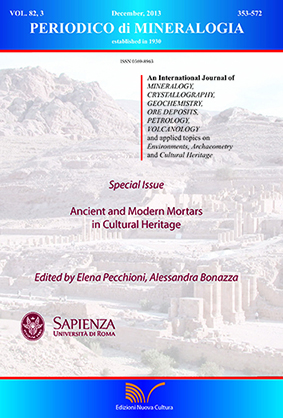Scientific analyses beyond the excavation: studies for a non invasive preliminary approach
DOI:
https://doi.org/10.2451/2013PM0028Keywords:
Mortar, XRD, ED-XRF, archaeology, multivariate analysis, on site analysisAbstract
Domo is an archaeological site located in the Foreste Casentinesi National Park, near the town of Bibbiena, in the province of Arezzo (Tuscany). Since the ’80, investigations at Domo have revealed a Roman domus with a Roman baths complex. Unfortunately, the rich stratigraphy was almost completely lost during the first excavations. Since 2008 the archaeological site was reopened by Archeodomani s.a.s., a company that deals with promotion of cultural heritage, and it is still under summer excavation campaigns.
In the future perspective to try and solve doubts about the site phase sequence of the Roman baths complex, not easy to understand now for several use modifications of the different areas, we developed an analytical method that could allow a large scale investigation limiting the sampling.
In this paper, we present the preliminary results obtained for mortar, both from the walls and from the binding of cocciopesto, with XRD (X Ray Diffraction) and ED-XRF (Energy Dispersive X-Ray Fluorescence) analysis on ground samples.
XRD analysis was performed at ICVBC-CNR and the diffraction data (Cu–Ka, 1.5418 Å) were collected on a J-J Panalytical X’Pert PRO spectrometer. Grounded samples were placed in aluminium sample holder or dusted on frosted glass sample holder, depending on sample amount.
XRF measurements were performed at Physics Department of Milan University using a portable EDXRF spectrometer (Assing Lithos 3000) exploiting polychromatic radiation from a Mo anode X-ray tube.
Both analyses were performed after preliminary observation of the samples by stereo-microscope and the results obtained through XRF and XRD were compared to get more complete information about samples. Data were also submitted to multivariate analysis (Hierarchical Clustering) to get material classification. The comparison between the classification obtained and archaeological interpretation is still in progress; the collection of analytical data will go on in future excavation campaigns. The complete overview will be part of a project to promote the archaeological site through an online portal.


